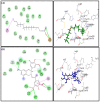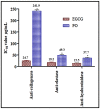Premna odorata: Seasonal Metabolic Variation in the Essential Oil Composition of Its Leaf and Verification of Its Anti-Ageing Potential via In Vitro Assays and Molecular Modelling
- PMID: 32521614
- PMCID: PMC7355609
- DOI: 10.3390/biom10060879
Premna odorata: Seasonal Metabolic Variation in the Essential Oil Composition of Its Leaf and Verification of Its Anti-Ageing Potential via In Vitro Assays and Molecular Modelling
Abstract
The metabolic variation in the essential oil composition of Premna odorata leaves obtained from different seasons was quantitatively and qualitatively determined employing GC/MS (Gas Chromatography coupled with Mass Spectrometry) and GC/FID (Gas chromatography equipped with flame ionization detector) techniques. It displayed the existence of 97 constituents accounting for 94.19%, 92.27%, 91.95% and 92.63% for POS (spring), POM (summer), POA (autumn) and POW (winter) whole essential oils. β-Caryophyllene constituting the main metabolite in the oil in the different seasons. To better visualize the differences between them, GC data were exposed to chemometric analysis. A PCA (principal component analysis) score plot revealed the closeness of POS and POW. Molecular modelling on collagenase, elastase and hyaluronidase enzymes active centres shows that different compounds existing in the essential oil of Premna odorata leaves shows binding to the active sites with variable degrees that suggested its anti-ageing potential. Palmitic acid displayed the highest fitting for both the collagenase and elastase active centres in both pH-based and rule-based ionization methods with ∆G equals -78.27 and -44.77 kcal/mol, respectively; meanwhile, heptacosane showed the highest fitting score in the hyaluronidase centre with ∆G = -43.78 kcal/mol. In vitro assays consolidates the obtained modelling studies in which essential oil shows considerable anti-elastase and anti-hyaluronidase potential as evidenced by their IC50 values being 49.3 and 37.7 μg/mL, respectively; meanwhile, the essential oil of Premna odorata leaves displayed mild anti-collagenase potential. Thus, it can be concluded that Premna odorata could serve as a promising anti-ageing naturally occurring drug that could be effectively incorporated by pharmaceutical industries in cosmetics combating ageing and skin wrinkling.
Keywords: GC/MS; Premna odorata; Verbenaceae; anti-ageing; essential oil; molecular modelling.
Conflict of interest statement
The authors declare no conflict of interest.
Figures








References
-
- Rekha K., Richa P., Babu S., Rao M. A phytochemistry of the genus Premna: A review. Int. J. Pharm. Chem. Sci. 2015;4:317–325.
-
- Pinzon L.C., Uy M.M., Sze K.H., Wang M., Chu I.K. Isolation and characterization of antimicrobial, anti-inflammatory and chemopreventive flavones from Premna odorata Blanco. J. Med. Plant Res. 2011;5:2729–2735.
-
- Gamal El-Din M.I., Youssef F.S., Ashour M.L., Eldahshan O.A., Singab A.N.B. Comparative analysis of volatile constituents of Pachira aquatica Aubl. and Pachira glabra Pasq., their anti-Mycobacterial and anti-Helicobacter pylori activities and their metabolic discrimination using chemometrics. J. Essent. Oil Bear. Plants. 2018;21:1550–1567. doi: 10.1080/0972060X.2019.1571950. - DOI
Publication types
MeSH terms
Substances
Grants and funding
LinkOut - more resources
Full Text Sources
Medical
Miscellaneous

